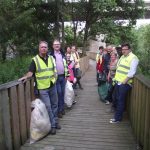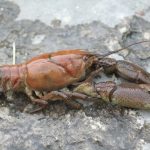The spread of the Invasive species Himalayan Balsam has been…
Tackling invasive species – biosecurity needs to be second nature to us all
In Ireland we are experiencing the same phenomena as seen globally, that is an increase in the number of non-native species arriving here. While most of these won’t be able to survive particularly well, some will thrive to the point of being invasive. Our wildlife and nature are under enough pressure as it is without introducing more problems. My hope for the coming years is that we will be better protected from invaders. The crux to achieving this is everyone playing a role in biosecurity.
Biosecurity is about taking measures to prevent the introduction and spread of invasive species. As an island, Ireland and Northern Ireland have a better opportunity than most to protect from new invaders being introduced. Intentional introductions tend to be through trade of plants, pets or live species for the pet and aquaria trade. Regulations banning trade and import of some invasive species are already in place and can be built upon. The biggest challenge is in preventing the introduction and spread of species that are introduced unintentionally. These tend to be as hitchhikers.
“Hitchhikers” are things like plant fragments, animals, seeds etc. hitchhiking on plants, in soil, on the hulls of boats, in bilge water, as contaminants of animal feed or fodder or even on our cars, boots or cargo. Taking measures such as sourcing native plants or products such as fodder generated in Ireland would help but we also need to act to prevent further spread of invasive species already in Ireland. For this a campaign of Check – Clean – Dry your equipment, footwear and clothing after being in aquatic areas is recommended whether invasive species are known to be in the waterbody or not. For land areas where invasive species are known to be present, then Check and Clean vehicles, boots etc. before leaving the area is important. Disinfection is a critical element in cleaning especially when tackling pathogens. In Ireland animals known to be kept as pets have been found in the wild such as Chipmunks and Slider turtles. While these species have restrictions on being traded and how they are kept under European law, being Pet Wise and considering the impacts if your pet escapes or is released to the wild before you buy it should be considered.
In the case that new invasive species do arrive, we need to have early detection surveillance and rapid response in place to remove them before it would be longer possible or feasible to do so.
I’m mindful that when fancying about the potential Ireland as an island has to protect it from new invaders, that measures taken in places like Australia including thorough border entry inspection as seen in the TV programme Border Control, does come with a high cost. Genovesi (2012) reports that the Australian biosecurity framework had a total budget of $1.6 billion from 2009 with $524.2 million of new funding for the 2012–2013 period. This budget was based on a collective effort from the agriculture, forestry, fisheries, and environment sectors, recognising the threat not only to biodiversity and the free services nature provides people, but also the economic threat to agriculture and forestry. This ambitious biosecurity approach has successfully kept Australia free of several highly invasive species.
When away at European level invasive species events where folk are discussing what they are developing or planning to do on invasive species, I can stand proud and say that Ireland has done so much of it already and can contribute in a real and practical way to find shared solutions to many of the issues. Ireland should give itself a pat on the back for achieving so much with such little resources given to it, but also recognise how much more needs to be done and that this needs to be properly resourced.
If we are to avoid leaving both a degraded environment and an immense financial bill for impact and control, we need to be fully implement existing policy and regulation, and for each of us to take responsibility and ownership to support vigorous implementation of the required biosecurity actions. While we don’t know what the future may bring, we should at least better invest in biosecurity measures now as prevention is better than cure, and less costly!
Hopefully by this time next year, as a reflection of a determined focus to protect our biodiversity and ecosystems, there will be biosecurity policies and wilful adoption of in Departments, agencies, clubs etc. throughout Ireland supporting every citizen and species to be better protected from invaders.
Case Study – Coypu
Species name: Coypu (Myocastor coypus)
Invasive status: Risk of high impact in Ireland. One of 37 EU Regulated invasive species.
Distribution status: Since first verified sighting in 2010, Coypu have reported from 7 locations. Just one animal was seen in 6 of the sites but a population of 10 animals was removed from Cork City in 2016. Continued presence in Cork City confirmed in May 2017.
Why of concern: Highly invasive impacting on wildlife, riverbank stability and is a pest of agriculture crops. High reproduction rates. Coypu may carry a number of diseases of importance to humans and domestic animals.
Pathway of introduction: Use in pet farms and as a pet species most likely.
Response to date: Rapid response triggered with animals removed from 3 different sites. Public species alert issued May 2017 to encourage reporting of sightings. Additional sightings confirmed for Cork City area.
Future outlook: eradication of isolated populations is possible. If Coypu became widely established in Ireland, it may not be possible/ feasible t o eradicate them.
How can future introductions be prevented: There are now Europe wide restrictions on trade, transports and in keeping Coypu. Those who currently have Coypu need to ensure they cannot escape confinement and cannot reproduce. If no longer wanted, they should be euthanized or rehomed in a licenced facility.
Case Study – Crayfish plague
Species name: Crayfish plague (Aphanomyces astaci)
Invasive status: Risk of high impact in Ireland.
Distribution status: Outbreak confirmed in 2 locations, the River Suir and the River Deel.
Why of concern: where present, the plague will kill all the protected White-clawed crayfish with impact on the waterbody ecology. Ireland has the world’s most important population of this species.
Pathway of introduction: Current source unknown. Plague can be introduced on wet infected equipment/clothing and by introduction of a plague carrying non-native crayfish. Non-native crayfish have not been recorded in Irish waters.
Response to date: Rapid Response triggered with dead crayfish specimens removed from suspected sites and tested. Extensive surveillance in infected sites to determine extent of crayfish kill and to try and determine if any non-native crayfish in the rivers. Public notices and awareness issued. Request issued for voluntary biosecurity practices to be implemented to prevent further spread and introduction into uninfected areas.
Future outlook: Not good! Risk of spread within infected catchments is almost inevitable and risk of introduction to currently uninfected areas is highly likely.
How can future introductions be prevented?: Biosecurity guidance to Check, Clean, Disinfect and thoroughly Dry all equipment and protective clothing is required when between waterbodies. Ideally, if equipment and clothing is used in an infected area then it should not be used in an uninfected area. Risk from trade of non-native crayfish needs to be addressed.
Collete O Flynn, National Biodiversity Data Centre
For further information on Coypu and Crayfish plague see: www.biodiversityireland.ie/projects/ invasive-species/species-alerts/
Outbreak of Crayfish Plague on a stretch of the River Suir downstream of Clonmel to Carrick-on-Suir
For information on how to Check, Clean and Dry see http://www.nonnativespecies.org/checkcleandry/







